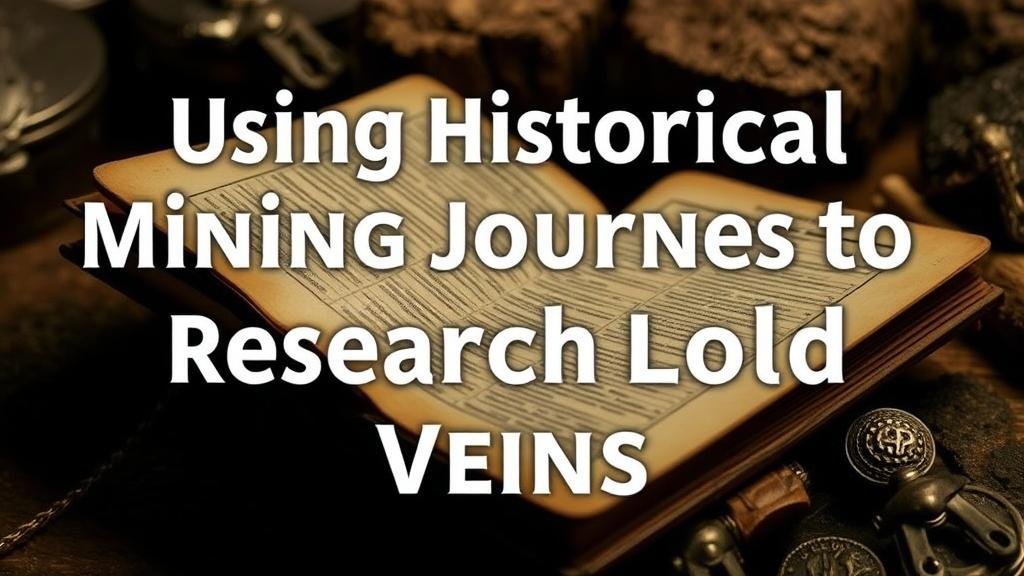Using Historical Mining Journals to Research Lost Gold Veins
Using Historical Mining Journals to Research Lost Gold Veins
The exploration and extraction of gold has captivated fortune seekers for centuries, especially during the gold rushes of the 19th century. The importance of lost gold veins, particularly in historically rich areas such as California, Nevada, and Alaska, has led researchers to seek innovative methodologies for locating these elusive resources. One underutilized resource in this pursuit is historical mining journals, which contain invaluable data and insights on geological formations, mining techniques, and ore locations. This article examines the relevance of these journals in modern geologic surveys and exploration efforts, utilizing case studies and historical context to illustrate their importance.
Understanding Historical Mining Journals
Historical mining journals are primary sources created by individuals involved in the mining operations during significant periods of gold extraction. These documents often include detailed descriptions of mining sites, methods employed in ore extraction, and the social contexts surrounding mining communities. Such journals can provide first-hand accounts that reflect the challenges and discoveries of their time.
- Content Types: Mining journals typically encompass maps, sketches, and written narratives.
- Authors: They are authored by miners, geologists, and sometimes local businessmen involved in the mining industry.
- Date Range: Many journals date back to the mid-1800s, coinciding with significant gold discoveries.
The Significance of Mining Journals in Modern Geology
Incorporating historical mining journals into contemporary exploration methods can aid geologists in identifying potential locations of lost gold veins. following points elucidate their significance:
- Geological Insights: Journals often describe the geology of the mining area, including rock types, ore deposits, and mineralization patterns, which can inform modern geologic models.
- Technological Context: The mining techniques employed in past operations reveal adaptive strategies that may still be applicable today
- Lost Claims: Journals can uncover information about mining claims that were abandoned or unexploited due to technological limitations or economic circumstances.
Case Studies: Practical Applications of Mining Journals
Case Study 1: California Gold Rush
During the California Gold Rush (1848-1855), prospectors documented their findings extensively. The journals of individuals like William H. Seward, who ventured into the Sierra Nevada, detail specific locations where gold was discovered.
For example, Seward’s journal entries note the “sticktite†formations near Gold Run, which geologists later identified as promising sites for gold veins due to the presence of quartz and metamorphic rock. Analysis of journals from this era can lead modern geologists to revisit these locations with modern techniques such as geochemical analysis and ground-penetrating radar.
Case Study 2: Klondike Gold Rush
The Klondike Gold Rush (1896-1899) produced various mining journals that described the geographic and climatic challenges faced by miners. A significant journal from this period, maintained by prospector Ed S. Hamilton, includes references to gold-bearing creeks and information on the topographic features of Bonanza Creek, where extensive mining occurred.
Studies of Hamilton’s writings indicate an intricate understanding of soil layers, which can guide modern-day explorations in assessing old digs that may have been overlooked. Techniques such as electromagnetic surveying can be particularly beneficial in comprehending the subsurface stratigraphy referenced in historical accounts.
Challenges in Utilizing Historical Mining Journals
Data Reliability and Interpretation
While mining journals can be indispensable, they come with challenges in terms of data reliability and interpretation:
- Subjectivity: Many entries are subjective and may exaggerate findings for reasons related to profit or publicity.
- Fading Knowledge: The terminology and context may not align with contemporary geological principles, necessitating careful translation and interpretation.
Integrating Modern Techniques
To effectively leverage the information from historical mining journals, it is crucial to integrate modern exploration methodologies. This collaboration can take various forms:
- Cross-Referencing Data: Using digital databases to validate historical data against current geological surveys can significantly enhance accuracy.
- Field Studies: Engaging in field studies that correlate historical locations with advanced geophysical surveys helps refine exploration efforts.
Conclusion and Actionable Takeaways
Historical mining journals remain a rich yet often overlooked resource for researchers and geologists in the search for lost gold veins. By analyzing the geological insights, mining techniques, and historical contexts these journals offer, the potential for rediscovery increases. Acknowledge their historical significance, but conjugate this sensitive data with modern exploration techniques for optimal results.
To apply these insights effectively:
- Conduct comprehensive reviews of historical mining journals, focusing on geographical details.
- Use modern exploration technologies in areas highlighted by historical accounts.
- Cross-reference findings with existing geological surveys to enhance the credibility of claims.
In pursuing lost gold veins, researchers should view historical mining journals not merely as relics of the past but as valuable tools that could lead to the discovery of forgotten wealth.



